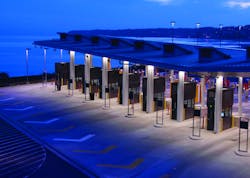U.S. Border-Crossing Station Earns LEED Gold Certification
Since the 9/11 terrorist attacks occurred, it’s no secret that safety measures between the United States and the Canadian and Mexican borders have been vastly heightened. The new Peace Arch Land Port of Entry is one such example of a modernized and more protected border-crossing station. Located in Blaine, Wash., the 12-acre site not only features state-of-the-art security technology, such as sophisticated vehicle tracking systems and campus-wide surveillance, but also includes a variety of energy-saving initiatives that earned it LEED Gold certification.
Situated within Peace Arch State Park approximately 30 miles from Vancouver, British Columbia, Canada, the original port of entry, which was constructed in 1976, comprised a modest primary inspection facility, eight inspection lanes, and an undersized secondary inspection area.
“This 3-year-long redevelopment project expanded the port of entry site from 3 acres to 12 acres, enlarged the primary facility that houses the offices of the Custom Border Protection (CBP) to around 35,000 sq ft, increased the number of inbound vehicle inspection lanes and booths to 10, and doubled the size of the secondary inspection area, where some automobiles are detained for closer inspection,” explains Ryan Binning, project manager for the Bellingham branch of Seattle-based VECA Electric, the company that performed electrical installations on the new overpass, the primary and secondary port buildings as well as the security, lighting control, and emergency power systems. Additional electrical work done by the contractor included parking and landscape lighting and installations related to vehicle inspection lifts, inspection booths, outdoor signage, and holding cells.
According to Binning, the size and complexity of the project, combined with strict security requirements and the need to coordinate among various Canadian and U.S. government entities — including CBP, the Environmental Protection Agency, the Office of Homeland Security, and the General Services Administration — made this project unique for VECA Electric.
“The primary building is a 2-story metallic panel and glass curtain wall-clad structure,” notes Binning. “The architecturally detailed interior includes a glass catwalk/bridge that spans the entire facility. These elements made it challenging to install the linear luminaires within the numerous pockets, soffits, canopies, and eyebrow ceiling areas.”
Adding to the project’s challenges was the need to build to LEED Gold standards. Energy-saving electrical features that helped achieve this goal include a sophisticated lighting control system and the widespread use of T5HO and T8 lamps as well as LEDs and dimming ballasts.
“In addition, occupancy sensors are installed throughout the primary and secondary facilities, and extensive daylight harvesting helps illuminate interior spaces and reduce electricity usage,” remarks Binning. “Dark Sky Friendly outdoor luminaires lessen light pollution and help prevent light spillage into the state park.”
A 22,000-sq-ft “green” roof located on the canopy over the secondary inspection area helps moderate temperatures below and decrease water run-off.
Since this project encompassed almost every facet of electrical construction, Binning says it proved an excellent learning experience for some of the company’s less seasoned employees.
“We took what we learned from this project and are applying it to other border-crossing stations locally and around the country,” he adds. “The new Peace Arch Land Port of Entry has become a prototype for similar structures.”
About the Author
Stefanie Kure
Content Producer - EC&M
Stefanie Kure is the senior associate editor of EC&M magazine. She holds a Bachelor of Arts degree from the University of Kansas and has more than 20 years of experience in the B2B magazine industry. In addition to EC&M, Stefanie has worked on Transmission & Distribution World magazine, Broadcast Engineering magazine, and Power Electronics Technology magazine.

